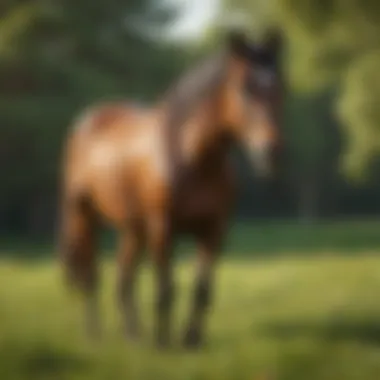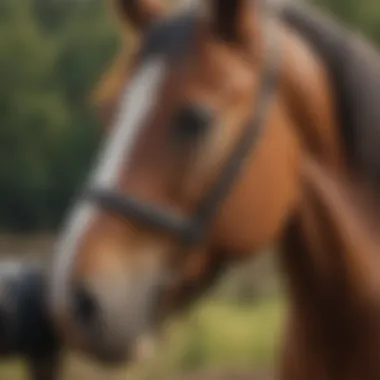Natural Fly Repellent for Horses: A Comprehensive Guide


Intro
Flies are a persistent nuisance for horses, impacting their health and overall well-being. This guide provides an in-depth look into natural fly repellents designed specifically for equine care. Understanding the implications of fly infestations is vital for horse owners who prioritize the welfare of their animals.
Topic Overview
Definition and Importance
Natural fly repellents are products derived from organic ingredients, intended to deter flies from horses without the use of harmful chemicals. These repellents are important because they not only protect the horses but also minimize environmental impact. The use of harsh synthetic chemicals can lead to adverse side effects both on animal health and the ecosystem. Thus, utilizing natural alternatives supports sustainable practices while offering effective protection against irritating pests.
Brief History and Evolution
Historically, horse caretakers relied heavily on chemical solutions to combat fly problems. However, rising awareness about their negative effects has led to a resurgence of interest in natural solutions. Over the years, knowledge of various herbs and oils that effectively repel flies has expanded, promoting the development of DIY recipes and products that utilize these natural ingredients.
Key Techniques and Innovations
Sustainable Farming Practices
Integrating natural fly repellents aligns well with sustainable agriculture. The emphasis is on cultivating a harmonious relationship between animals, crops, and the ecosystem. Practices such as rotational grazing and maintaining cleanliness in stables are vital aspects that contribute to reducing fly populations. These methods not only assist in fly control but also enhance overall farm health.
Advanced Agronomic Technologies
Recent advancements in agronomy, such as precision agriculture, are also influential. Technologies that help monitor livestock health can alert caretakers about the presence of flies or other pests. Increased awareness and monitoring lead to timely interventions using natural methods, improving both horse comfort and farm productivity.
Practical Applications
Step-by-Step Guides
Creating your own natural fly repellent can be straightforward. Here’s a simple guide:
- Gather Ingredients: Common ingredients include apple cider vinegar, essential oils like lavender, eucalyptus, or peppermint, and witch hazel.
- Mix the Solution: Combine one cup of apple cider vinegar with two cups of water. Add 20 drops of chosen essential oil.
- Store Properly: Use a spray bottle for storage and label it clearly. Remember to shake well before each use.
- Apply Effectively: Spray the mixture onto the horse’s coat, avoiding the eyes. Reapply every few hours, especially after rain or heavy sweating.
Case Studies or Real-World Examples
Many equine facilities have reported success with natural repellents. For instance, a local stable implemented a regimen of using herbal sprays. They observed a significant decrease in fly numbers and improvements in horse comfort levels. Such examples underscore the practicality and effectiveness of natural solutions in real-world settings.
"Natural solutions for fly management have transformed our approach to equine care. Horses feel more comfortable and we feel good about what we are using." - Local Stable Owner
Understanding how to harness natural fly repellents not only fosters the well-being of horses but also contributes to sustainable agricultural practices.
Understanding the Problem: Flies and Horses
Understanding the relationship between flies and horses is crucial for any horse owner. Flies are not only a nuisance but they can also significantly impact horse health and performance. This section discusses various aspects related to flies, including their life cycle, the risks they pose to horses, and how to effectively evaluate their population density.
The Life Cycle of Common Horse Flies
Common horse flies, such as the green bottle fly and horse fly species, undergo a complex life cycle comprising four stages: egg, larva, pupa, and adult. Female flies lay eggs on or near water sources or damp areas, providing ideal conditions for larvae to develop. The larval stage can last several weeks, during which the immature fly consumes organic matter. Once the larvae mature, they pupate, emerging as adult flies after a short period. Understanding this cycle is essential for effective fly management, as intervention at specific stages can greatly reduce fly populations.
Health Risks Posed by Fly Infestations
Fly infestations can lead to various health risks for horses. The main categories of risks include skin irritations, infections and diseases, and behavioral impacts.
Skin irritations
Skin irritations caused by fly bites are one of the most immediate effects of infestations. Horses can develop itchy welts, leading to discomfort and stress. The presence of bites can result in frequent scratching and rubbing against surfaces, which exacerbates the skin damage. This irritation is not just a cosmetic issue; it can lead to open wounds that may become infected if not properly managed. Understanding the causes and addressing them promptly helps maintain the horse's comfort and well-being.
Infections and diseases
Fly bites do not only cause irritation; they can also transmit infections and diseases. Common threats include diseases like equine influenza and West Nile virus, transmitted through the bites of infected flies. The risk of illness increases during fly peak seasons, necessitating close monitoring and fostering preventative measures. Assessing the potential infectious risks associated with specific fly species provides insight into the health challenges that owners need to prepare for.
Behavioral impacts


Behaviorally, flies can cause significant disturbances. Horses may exhibit anxiety or aggression due to constant fly irritation. This stress affects their feeding habits and performance in work or competitions. By understanding how fly populations influence a horse's behavior, owners can implement flying prevention measures to help foster a calmer environment for their horses.
Evaluating Fly Population Density
Evaluating fly density is critical in determining the level of infestation and consequent risks.
Signs of heavy fly presence
Signs such as an increase in flies around watering areas, feed buckets, or stabling environment can indicate heavy fly presence. Observing these signs helps in taking timely action, potentially preventing further infestations.
Environmental factors influencing populations
Environmental factors such as temperature, humidity, and sanitation can greatly impact fly populations. Warm and wet weather can lead to higher fly activity. Maintaining a clean environment, managing standing water, and employing proper waste management strategies can contribute to controlling fly density effectively.
Natural Ingredients for Fly Repellents
Natural ingredients play a vital role in crafting effective fly repellents for horses. With the increasing concern over the potential adverse effects of synthetic substances, horse owners are turning to nature for safer alternatives. Natural fly repellents provide not only protection but also promote overall equine well-being. Moreover, many natural ingredients have additional benefits, such as soothing skin irritations or insect bites. This section discusses essential oils, vinegar, and herbal additives, focusing on their efficacy and unique characteristics.
Essential Oils and Their Efficacy
Essential oils have gained popularity as effective natural fly repellents due to their distilling properties and pleasant scents. Here, we explore three notable oils:
Peppermint oil
Peppermint oil is known for its strong aroma, which is often aversive to many flying insects, including flies. Its high menthol content is a key factor for its repellency. This oil is a great choice for freshening up the horse's area, but its high concentration can be irritating when undiluted. Therefore, it must be used with care when preparing repellent mixtures.
Lavender oil
Lavender oil is renowned for its calming properties, making it a popular choice among horse owners seeking a holistic approach to fly management. Its floral scent not only repels flies but also soothes anxious horses. Lavender oil’s versatility makes it beneficial as it can be combined with other oils to create a pleasant-smelling spray. However, it's essential to monitor the horse's reaction, as some may not enjoy the scent.
Eucalyptus oil
Eucalyptus oil is another potent repellent due to its strong fragrance and insect-repelling qualities. It is effective against a variety of flying insects. Furthermore, eucalyptus oil has natural antimicrobial properties, providing an added layer of protection to the horse's skin. Like other essential oils, it should be mixed correctly with a carrier to avoid skin irritation, especially in sensitive horses.
Vinegar: A Versatile Component
Vinegar is an excellent natural ingredient that serves multiple purposes. Its sharp scent can deter flies effectively. It can be combined with essential oils for enhanced efficacy. Moreover, vinegar can also help clean the horse's environment by eliminating odors that attract flies. When using vinegar in repellent recipes, a balance is vital, as high concentrations can lead to irritation. Apple cider vinegar is often preferred for its additional health benefits.
Herbal Additives and Their Benefits
Herbal additives not only repel flies but also provide some additional health benefits for horses. Here we look at three essential herbs:
Rosemary
Rosemary is known for its strong scent, which acts as a powerful insect repellent. Its essential oil is often used in fly spray formulations, and its other properties may help stimulate circulation and improve skin health. Its unique feature is the natural antioxidants it contains. However, horses may have different preferences for scents, so it's important to test it before regular use.
Cedarwood
Cedarwood is another herb that benefits horse owners looking for natural repellents. Its woody aroma helps create an inhospitable environment for flies. Cedarwood oil is often used in diluted spray forms. Its unique feature lies in its ability to repel a broad range of flying insects. However, some horses may find cedarwood oil too strong, warranting careful consideration in application.
Neem
Neem is a widely recognized herb for its natural insect repelling properties. Known for its ability to deter various pests, it can be beneficial for horses vulnerable to fly infestations. Additionally, neem possesses antifungal and antibacterial properties. This oil is a popular option for those looking for a multipurpose repellent. However, neem's scent is quite potent, so it’s crucial to gauge the horse’s tolerance before its use.
The selection of natural ingredients for fly repellents not only enhances efficacy but also promotes the health and comfort of horses.
DIY Natural Fly Repellent Recipes
Creating your own natural fly repellent is a practical solution for horse owners. DIY recipes allow you to control ingredients, ensuring safety for your horse while managing fly populations effectively. By using natural components, you minimize harmful chemical exposures and the impact on the environment. Furthermore, making these repellents can be cost-effective, as many natural ingredients are readily available or inexpensive. Understanding how to craft these mixtures empowers horse owners to tailor solutions to their specific needs.
Basic Fly Spray Recipe


Ingredients and Proportions
The basic fly spray recipe serves as a foundation for effective fly management. Key ingredients often include water, vinegar, and essential oils like lavender or peppermint. A common proportion is one part vinegar to two parts water, with 10-15 drops of essential oil added to enhance effectiveness. This combination is effective due to the strong scents from essential oils, which flies find repulsive. It is important to remember that the type of vinegar used can affect the scent; apple cider vinegar is often preferred for its more pleasant aroma. By using essential oils, horse owners can benefit from natural properties that deter flies without causing harm to their horses.
Preparation Method
Preparation of the basic fly spray is straightforward, contributing to its popularity. Just mix ingredients in a spray bottle, shaking gently to blend them. This simplicity makes it accessible for many horse owners, allowing for quick application. Furthermore, this method does not require specialized equipment or extensive knowledge. However, it is essential to ensure that the spray bottle is clean to avoid contamination. Storage in a cool, dark place is recommended for longevity of the mixture. Regular shaking before use helps to maintain the efficacy of the oils and prevents separation.
Advanced Formulations
Combining Oils for Enhanced Effect
Combining various essential oils can significantly increase the repellent's effectiveness. For instance, blending lavender oil with eucalyptus creates a more complex scent that is even more unappealing to flies. Each oil brings unique properties; while some may repel, others may provide soothing effects on the horse's skin. This multi-faceted approach allows for a comprehensive solution against flies. It is crucial to research which combinations yield the best results for specific fly species prevalent in your area. However, it's also important to test the mix on a small area first to monitor for any allergic reactions.
Custom Tailoring for Specific Environments
Tailoring your fly repellent for specific environments is another key aspect of advanced formulations. Factors like location, season, and weather can influence fly behavior and population density. For example, if your horses are near a standing water source, a formulation with more potent repellents may be necessary. Alternatively, in drier environments, lighter mixtures might suffice. Understanding these dynamics enables horse owners to adjust the ratios and types of ingredients based on their conditions. However, this may require some trial and error to find the perfect blend that works best in your situation.
Storage and Safety Precautions
When preparing natural fly repellents, it is essential to follow proper storage and safety precautions. Store your formulations in labeled containers to avoid confusion. Some essential oils can degrade over time when exposed to light and air, so using dark glass bottles is advisable. Always keep these products away from pets and children, as they may not understand the potential hazards. Additionally, it’s prudent to conduct a patch test on your horse before applying any new mixture broadly. This precaution helps identify any adverse reactions before widespread use. Overall, this responsible approach ensures both efficacy and safety.
Application Techniques for Effective Coverage
Effective application techniques are crucial to ensuring that natural fly repellents provide maximum protection for horses. The method of application can significantly affect the effectiveness of a product, altering how thoroughly it covers the horse's coat and how long it lasts. Understanding both the timing and the right methods improves not only the efficacy of the repellent but also the comfort and well-being of the horse.
Intensity of fly presence often varies during the day and changes with weather conditions. Therefore, identifying the best time for application can lead to better management outcomes. The following subsections provide insight into both timing and frequency of application as well as various methods of application that horse owners should consider.
Timing and Frequency of Application
The timing of applying natural fly repellents is essential in combating fly populations. Applications are most effective during peak fly hours, which tend to be early in the morning and later in the afternoon. Reapplying the repellent at intervals, especially after rain or excessive sweating, is necessary. Regular application can ensure that horses are consistently protected from these pests. Determining the right schedule also allows for better alignment with your horse's routine, making it easier to maintain a protective environment.
Methods of Application
Spraying on coats
Spraying repellents directly onto the coat is one of the most common methods used by horse owners. This method provides a direct application from head to tail. It helps to cover large areas quickly, ensuring that all parts of the coat are protected.
The key characteristic of spraying on coats is its ability to create a barrier against flies almost immediately. It is beneficial since it allows for easy reapplication whenever necessary, particularly during peak fly times. An important advantage of spraying is that it can be done while grooming, making it part of the horse's regular care routine. However, care must be taken to avoid over-saturation, which could lead to skin irritation in sensitive horses.
Soaking grooming tools
Soaking grooming tools in a natural fly repellent solution is another effective method for applying repellent to horses. This method not only treats the coat but also conditions it. When tools such as brushes are soaked, they transfer the repellent to the horse’s coat as they groom.
The unique feature of this method is that it allows for a gentle approach unlike direct sprays, which may startle some horses. Moreover, this method assists in maintaining a coat's condition while simultaneously repelling flies. One disadvantage, however, is the potential for uneven coverage depending on how thoroughly the grooming is done. Owners need to ensure they cover all parts and to use the right tools for effective application.
Overall, correctly applying natural fly repellents is vital for protecting horses from fly infestations. The methods chosen should align with the horse’s preferences while ensuring sufficient coverage for the best results.
Environmental and Behavioral Considerations
Understanding the environmental and behavioral aspects of using natural fly repellents is essential for effective management. Choosing the appropriate setting for application can greatly impact the success of the repellent. Factors such as the horse’s surroundings, the time of year, and weather conditions play crucial roles. For instance, applying a repellent in a shaded area might be more effective since horses often seek such places to avoid sunlight and flies. Additionally, taking into account the horse’s daily routine and habits will lead to a more successful application strategy.
When considering the horse’s preferences, it is important to remember that each horse may respond differently to various natural ingredients. Some horses may dislike the smell of certain essential oils, while others could be indifferent. Tailoring the application based on individual behavior can foster a more comfortable and stress-free experience for the horse. If a horse shows signs of discomfort or agitation during application, trying a different method or formulation could lead to better acceptance and efficacy.
By observing the horse's reactions and adjusting accordingly, horse owners can maximize the efficacy of natural repellents while minimizing stress on the animal.
Choosing the Right Setting for Application
Selecting the right environment for applying natural fly repellents can dictate their effectiveness. Ideally, application should occur where the horse usually spends its time, whether in a barn, pasture, or open field. This ensures that the repellent will be in the horse's immediate territory, deterring flies effectively.
In open pastures, the application might be less effective if the horse is frequently moving to different areas. In contrast, if the horse is in a stable or enclosed area, it is important to apply the repellent just before the horse enters or while it is in that space. Also, avoiding windy days is wise, as wind can disperse the active ingredients quickly, reducing their efficacy.


Recognizing Individual Horse Preferences
Recognizing individual horse preferences is key to ensuring the repellent is not only effective but also well-tolerated. Some horses may prefer a lighter scent or feel comfortable with certain natural substances over others. Observing a horse’s body language during application can provide immediate feedback on its comfort level.
It can be beneficial to test several formulations or methods until finding one that the horse tolerates well. Keeping track of how each horse reacts to different scents and textures can help in creating a customized approach. Additionally, using rewards during and after application may encourage positive associations with the process, leading to smoother experiences in the future.
Comparative Analysis: Natural vs. Synthetic Repellents
Evaluating the distinctions between natural and synthetic fly repellents is central to understanding their impact on horse health and management. Natural fly repellents often leverage ingredients derived from plants and essential oils, which can offer effective alternatives to chemical-based products. In contrast, synthetic repellents typically contain man-made chemicals designed for immediate efficacy. However, this evaluation goes beyond mere effectiveness; it includes concerns regarding safety, long-term use, and sustainability.
Efficacy Evaluation
The efficacy of natural repellents can vary based on their ingredients, application methods, and the specific fly species being addressed. Studies have shown that essential oils like peppermint and eucalyptus can deter flies effectively. A combination of these oils often multiplies their repellent effects. Conversely, synthetic options usually guarantee more consistent results because they are engineered for specific pest control.
- Advantages of Natural Repellents:
- Disadvantages of Synthetic Repellents:
- Often safer for horses and humans
- Typically environmentally friendly
- Potential health risks with prolonged exposure
- May cause skin irritations in sensitive horses
Surveying the market, many horse owners express a preference for natural solutions. Efficacy is essential, but safety is paramount.
Cost-Effectiveness
When considering cost, natural fly repellents can have both higher and lower initial costs compared to synthetic ones. DIY recipes may offer an economical route, reducing expenditure while providing effective pest control. However, these often require frequent reapplication, potentially increasing labor costs.
- Synthetic Options:
- Natural Options:
- Typically higher upfront costs
- Longer lasting results, reducing the need for continuous purchases
- Can be made from inexpensive ingredients
- Frequent application may lead to higher overall costs
Understanding cost-effectiveness requires a broader view of long-term health benefits and environmental impact. A one-time cost for synthetic may seem appealing, but the implications of chemical use often outweigh initial savings.
Long-Term Health Implications
The health implications associated with synthetic repellents can be significant. Long-term exposure to chemicals used in these products can lead to various health issues in horses, such as skin irritation and systemic diseases. In contrast, natural alternatives boast a safer profile, often leading to fewer adverse effects when used properly.
"Natural repellents do not only assist in fly management; they also contribute to the overall well-being of horses, minimizing chemical exposure in their daily environment."
- Considerations for Horse Owners:
- Final Thought:
- Evaluate the horse’s history of skin sensitivities
- Assess the frequency of fly problems in the stable
- Long-term health remains a priority in fly management strategies
In summary, the comparative analysis of natural vs. synthetic repellents reveals a complex interplay of efficacy, cost, and health implications. Horse owners must carefully consider these factors in their choice of fly management techniques.
The End: The Future of Natural Fly Management
Natural fly management is an essential consideration for horse owners dedicated to the well-being of their animals. As flies continue to pose health risks, the focus on sustainable and effective solutions has grown significantly. This guide emphasizes a shift towards the utilization of natural repellents, which not only enhance horse health but also promote environmental stewardship.
Sustainable Practices in Equine Care
The integration of sustainable practices in equine care is vital for long-term efficacy and health. Adopting natural fly repellents aligns with a broader emphasis on eco-friendly methods. These practices include:
- Utilizing locally sourced ingredients, reducing transportation emissions.
- Emphasizing organic farming techniques around stables, which can minimize fly breeding.
- Educating horse owners on mindful grazing practices that can help manage pasture conditions, lowering fly populations.
Implementing these practices supports overall horse health while respecting natural ecosystems. Moreover, by fostering a holistic approach to equine care, horse owners are able to create healthier environments that lessen reliance on chemical solutions.
Continued Research and Development
Ongoing research into natural fly repellents is crucial to enhance their effectiveness and broaden their applications. Current studies are exploring:
- New Natural Compounds: There is a need for more innovative natural ingredients that can serve as effective repellents.
- Formulation Technologies: Developing advanced methods to combine ingredients for better longevity and strength.
- Feedback from Users: Horse owners’ experiences can guide improvements in natural fly repellents, helping manufacturers tailor their products to real-world applications.
Future research will likely uncover novel solutions, ensuring that horse owners have a wide range of options that align with their care philosophy. By prioritizing natural products, the equine community can move toward safer, healthier, and more sustainable fly management practices.
"By investing in sustainable practices and supporting ongoing research, we can enhance the quality of life for horses while fostering an environmentally responsible approach to equine care."
Through the continuation of these practices and developments, the future of natural fly management appears promising. Horse owners must stay informed and adapt their methods to ensure optimal health for their equine companions.



